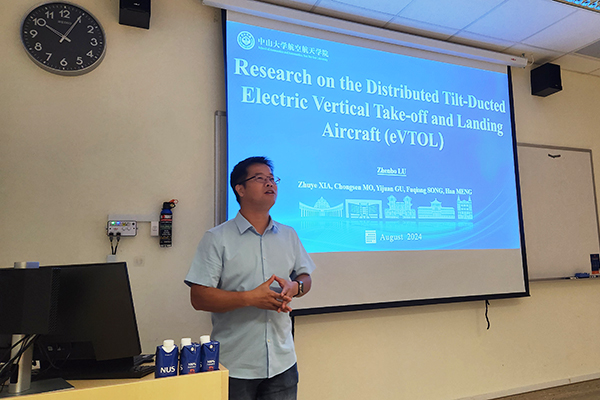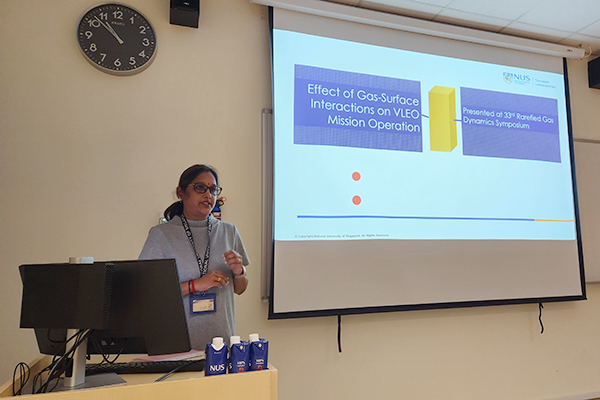Seminar
Research on the Distributed Tilt-Duct Electric Vertical Take-off and Landing Aircraft (eVTOL) |
| 2 August 2024, Friday, 10:00am to 10:30am | Speaker: Professor Lu Zhenbo, Adjunct Senior Research Scientist, Temasek Laboratories, NUS, School of Aeronautics and Astronautics, Sun Yat-sen University |
| Venue: Seminar Room 8D-1, Level 8, Temasek Laboratories | Event Organiser Host: Dr. Huang Xin |
|
ABSTRACT |
Recent years, low-altitude aircraft represented by electric vertical take-off and landing aircraft (eVTOL) have become a frontier hot research topic in the aviation field, and the study of aerodynamic configuration is of great significance for aircraft design. As an intelligent, low-noise, low-cost, green, and high-safety future general aviation aircraft, eVTOL is the core equipment of the urban air mobility system, and its application will drive a new trillion-level industry. However, due to the complex environment of low-altitude airspace and the requirements of multi-modal flight such as vertical take-off and landing, cruise, etc., it is still difficult to realize the high-efficiency and low-noise eVTOL aerodynamic configuration. The distributed tilt-duct fan configuration offers the best payload, maximum take-off weight and operating economy, but it also presents significant technical challenges. Our team are focusing on the aerodynamic configuration and distributed propulsion technology, and comprehensively apply advanced aerodynamic design methods to develop a distributed tilt ducted fan-type electric drive vertical take-off and landing aircraft that meets the requirements of aviation safety. |
| ABOUT THE SPEAKER |
|

Effect of Gas Surface Interactions on VLEO Mission Operation |
| 2 August 2024, Friday, 10:30am to 11:00am | Speaker: Dr. Sai Sudha Ramesh, Senior Research Scientist, Temasek Laboratories, National University of Singapore |
| Venue: Seminar Room 8D-1, Level 8, Temasek Laboratories | Event Organiser Host: Dr. Huang Xin |
|
ABSTRACT |
The recent increase in very low Earth orbit (VLEO) satellite operations has triggered the necessity to consider the influence of gas-surface interactions (GSI) in estimating accurate aerodynamic drag coefficients for mission operations as opposed to constant drag coefficient assumptions. The present study leverages the capability of test particle Monte Carlo (TPMC) method, which is computationally efficient compared to direct simulation Monte Carlo (DSMC) in modeling the influence of GSI on orbital trajectory. With predominance of atomic oxygen (ATOX) in VLEO, the randomness in scattered direction due to diffuse reflection increases, leading to significant contribution of shear along surfaces parallel to incoming flow. Potential mitigation includes the application of ATOX resistant material coatings which result in specular reflection of particles. In this talk, the influence of specularly reflective materials on satellite aerodynamic drag and mission operations will be presented. |
| ABOUT THE SPEAKER |
|




 Professor Lu Zhenbo, Adjunct senior research scientist, Temasek Laboratories, National University of Singapore. Also professor of the School of Aeronautics and Astronautics, Sun Yat-sen University, received bachelor and master degree in aerospace propulsion theory and engineering from Beihang University (BUAA), and PhD degree in mechanical engineering from the Hong Kong Polytechnic University (PolyU). He has worked in the National University of Singapore for about 11 years. Now served as a youth editorial board member of journals such as Journal of Aeronautical Sciences, Aerospace Technology and Aerodynamics, technical consultant of COMAC Beijing Civil Aircraft Technology Research Center, and member of the Low Transonic Professional Committee of the Chinese Society of Aerodynamics. The main research includes electric vertical take-off and landing vehicle (eVTOL), aircraft aerodynamic design, aerodynamic noise, artificial intelligence, bionic flapping wing aircraft, acoustic metasurface, smart materials and structures, noise and vibration and etc.
Professor Lu Zhenbo, Adjunct senior research scientist, Temasek Laboratories, National University of Singapore. Also professor of the School of Aeronautics and Astronautics, Sun Yat-sen University, received bachelor and master degree in aerospace propulsion theory and engineering from Beihang University (BUAA), and PhD degree in mechanical engineering from the Hong Kong Polytechnic University (PolyU). He has worked in the National University of Singapore for about 11 years. Now served as a youth editorial board member of journals such as Journal of Aeronautical Sciences, Aerospace Technology and Aerodynamics, technical consultant of COMAC Beijing Civil Aircraft Technology Research Center, and member of the Low Transonic Professional Committee of the Chinese Society of Aerodynamics. The main research includes electric vertical take-off and landing vehicle (eVTOL), aircraft aerodynamic design, aerodynamic noise, artificial intelligence, bionic flapping wing aircraft, acoustic metasurface, smart materials and structures, noise and vibration and etc. 
 Dr. Sai Sudha Ramesh received her B.E and M.E in Civil Engineering from BITS, Pilani, India. She received her Ph.D. from National University of Singapore in 2010. After a brief stint as Research fellow in the Department of Mechanical Engineering, NUS, she joined Temasek Laboratories in 2015. She is currently a Senior Research Scientist and her research interests encompass different topics such as computational acoustics, reduced order modelling, turbulent wakes and satellite aerodynamics. Her current research focus in on aerodynamic drag experienced by satellites in very low Earth orbits (VLEO).
Dr. Sai Sudha Ramesh received her B.E and M.E in Civil Engineering from BITS, Pilani, India. She received her Ph.D. from National University of Singapore in 2010. After a brief stint as Research fellow in the Department of Mechanical Engineering, NUS, she joined Temasek Laboratories in 2015. She is currently a Senior Research Scientist and her research interests encompass different topics such as computational acoustics, reduced order modelling, turbulent wakes and satellite aerodynamics. Her current research focus in on aerodynamic drag experienced by satellites in very low Earth orbits (VLEO).